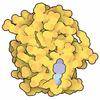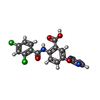Entry Database : PDB / ID : 1wm0Title PPARgamma in complex with a 2-BABA compound 14-mer from Nuclear receptor coactivator 2 Peroxisome proliferator activated receptor gamma Keywords / / Function / homology Function Domain/homology Component
/ / / / / / / / / / / / / / / / / / / / / / / / / / / / / / / / / / / / / / / / / / / / / / / / / / / / / / / / / / / / / / / / / / / / / / / / / / / / / / / / / / / / / / / / / / / / / / / / / / / / / / / / / / / / / / / / / / / / / / / / / / / / / / / / / / / / / / / / / / / / / / / / / / / / / / / / / / / / / / / / / / / / / / / Biological species Homo sapiens (human)Method / / Resolution : 2.9 Å Authors Ostberg, T. / Svensson, S. / Selen, G. / Uppenberg, J. / Thor, M. / Sundbom, M. / Sydow-Backman, M. / Gustavsson, A.L. / Jendeberg, L. Journal : J.Biol.Chem. / Year : 2004Title : A new class of peroxisome proliferator-activated receptor agonists with a novel binding epitope shows antidiabetic effectsAuthors : Ostberg, T. / Svensson, S. / Selen, G. / Uppenberg, J. / Thor, M. / Sundbom, M. / Sydow-Backman, M. / Gustavsson, A.L. / Jendeberg, L. History Deposition Jul 1, 2004 Deposition site / Processing site Revision 1.0 Sep 7, 2004 Provider / Type Revision 1.1 Apr 30, 2008 Group Revision 1.2 Jul 13, 2011 Group Revision 1.3 Mar 13, 2024 Group / Database references / Derived calculationsCategory chem_comp_atom / chem_comp_bond ... chem_comp_atom / chem_comp_bond / database_2 / struct_ref_seq_dif / struct_site Item _database_2.pdbx_DOI / _database_2.pdbx_database_accession ... _database_2.pdbx_DOI / _database_2.pdbx_database_accession / _struct_ref_seq_dif.details / _struct_site.pdbx_auth_asym_id / _struct_site.pdbx_auth_comp_id / _struct_site.pdbx_auth_seq_id
Show all Show less
 Open data
Open data Basic information
Basic information Components
Components Keywords
Keywords Function and homology information
Function and homology information Homo sapiens (human)
Homo sapiens (human) X-RAY DIFFRACTION /
X-RAY DIFFRACTION /  MOLECULAR REPLACEMENT / Resolution: 2.9 Å
MOLECULAR REPLACEMENT / Resolution: 2.9 Å  Authors
Authors Citation
Citation Journal: J.Biol.Chem. / Year: 2004
Journal: J.Biol.Chem. / Year: 2004 Structure visualization
Structure visualization Molmil
Molmil Jmol/JSmol
Jmol/JSmol Downloads & links
Downloads & links Download
Download 1wm0.cif.gz
1wm0.cif.gz PDBx/mmCIF format
PDBx/mmCIF format pdb1wm0.ent.gz
pdb1wm0.ent.gz PDB format
PDB format 1wm0.json.gz
1wm0.json.gz PDBx/mmJSON format
PDBx/mmJSON format Other downloads
Other downloads 1wm0_validation.pdf.gz
1wm0_validation.pdf.gz wwPDB validaton report
wwPDB validaton report 1wm0_full_validation.pdf.gz
1wm0_full_validation.pdf.gz 1wm0_validation.xml.gz
1wm0_validation.xml.gz 1wm0_validation.cif.gz
1wm0_validation.cif.gz https://data.pdbj.org/pub/pdb/validation_reports/wm/1wm0
https://data.pdbj.org/pub/pdb/validation_reports/wm/1wm0 ftp://data.pdbj.org/pub/pdb/validation_reports/wm/1wm0
ftp://data.pdbj.org/pub/pdb/validation_reports/wm/1wm0 Links
Links Assembly
Assembly
 Components
Components Homo sapiens (human) / Plasmid: pET28 / Species (production host): Escherichia coli / Production host:
Homo sapiens (human) / Plasmid: pET28 / Species (production host): Escherichia coli / Production host: 
 X-RAY DIFFRACTION / Number of used crystals: 1
X-RAY DIFFRACTION / Number of used crystals: 1  Sample preparation
Sample preparation ROTATING ANODE / Type: RIGAKU RU300 / Wavelength: 1.5418 Å
ROTATING ANODE / Type: RIGAKU RU300 / Wavelength: 1.5418 Å Processing
Processing MOLECULAR REPLACEMENT / Resolution: 2.9→14.7 Å / Cor.coef. Fo:Fc: 0.946 / Cor.coef. Fo:Fc free: 0.877 / SU B: 13.536 / SU ML: 0.271 / Cross valid method: THROUGHOUT / σ(F): 3.2 / ESU R Free: 0.457 / Stereochemistry target values: MAXIMUM LIKELIHOOD
MOLECULAR REPLACEMENT / Resolution: 2.9→14.7 Å / Cor.coef. Fo:Fc: 0.946 / Cor.coef. Fo:Fc free: 0.877 / SU B: 13.536 / SU ML: 0.271 / Cross valid method: THROUGHOUT / σ(F): 3.2 / ESU R Free: 0.457 / Stereochemistry target values: MAXIMUM LIKELIHOOD Movie
Movie Controller
Controller



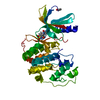


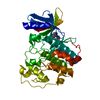
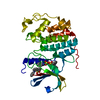
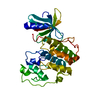
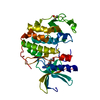
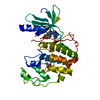

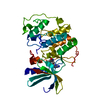
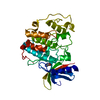
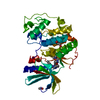
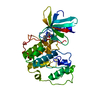
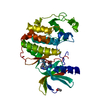

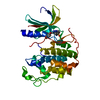
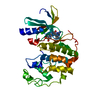
 PDBj
PDBj



